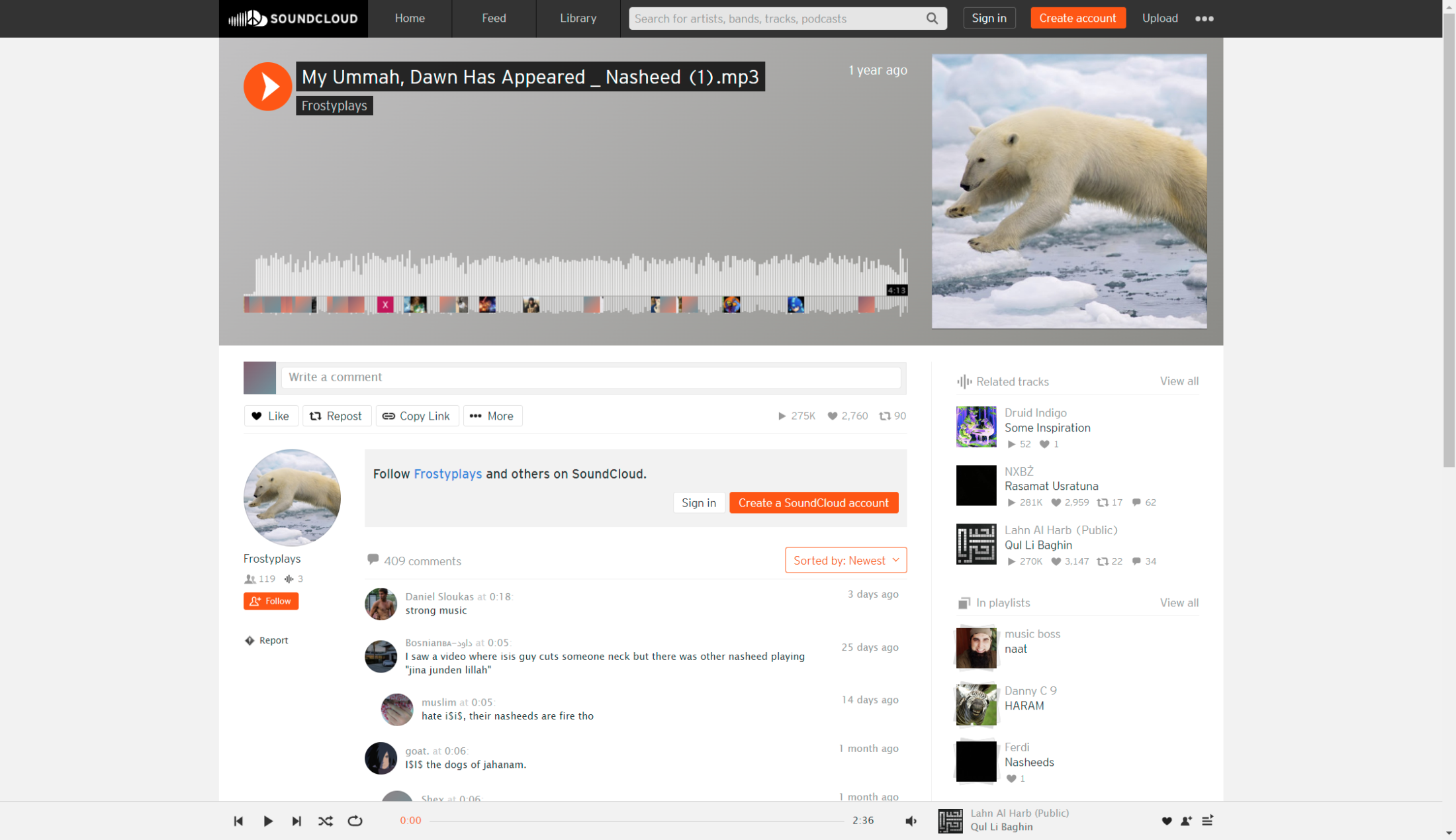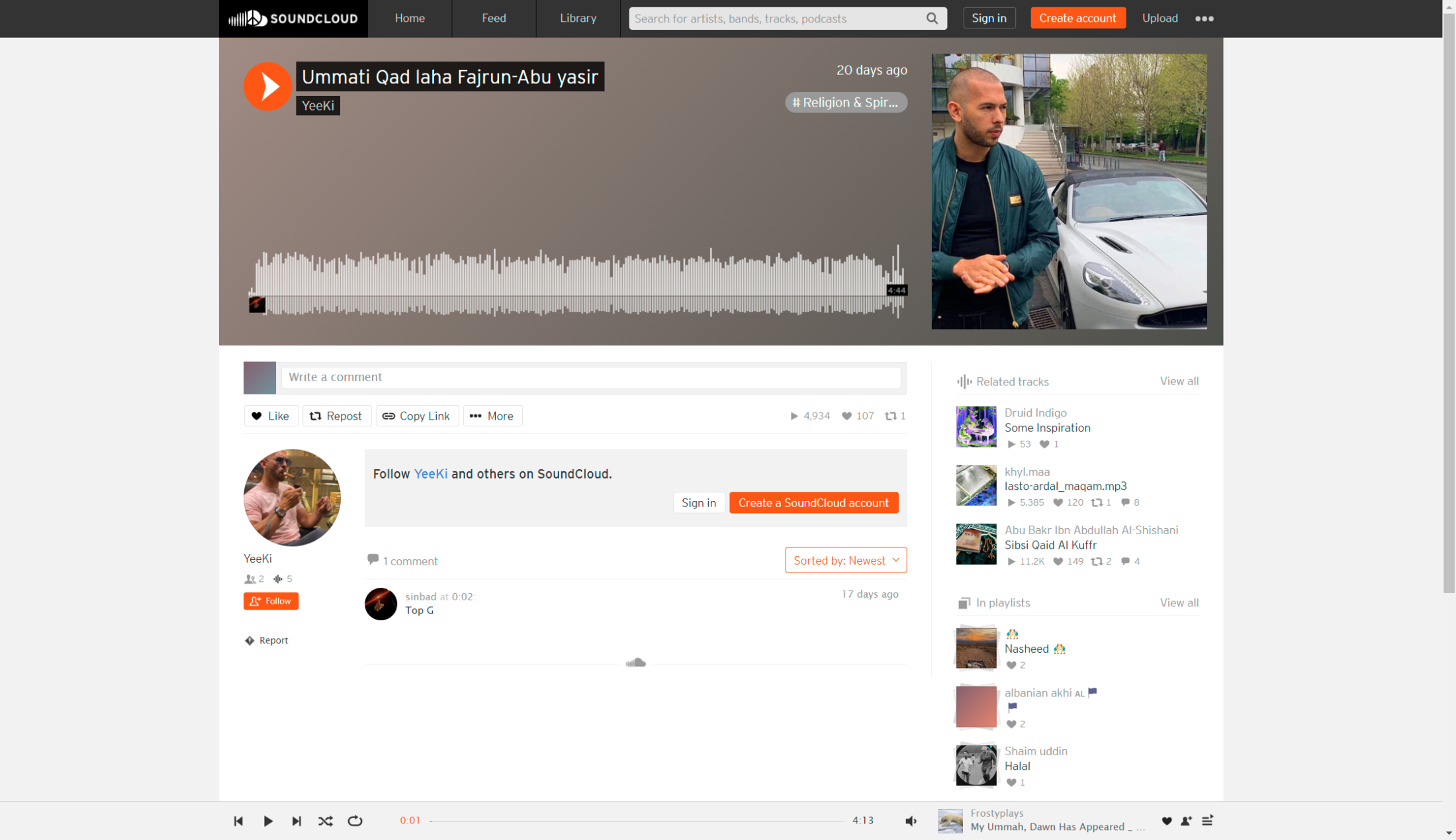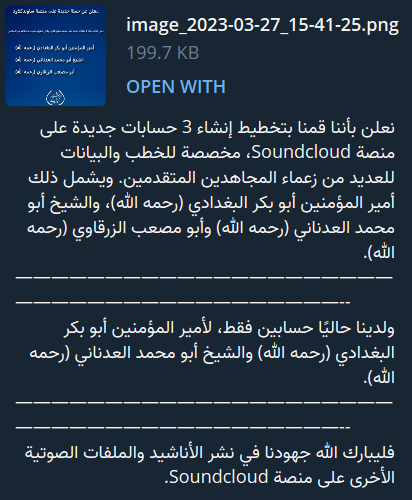As with all guest posts, the opinions expressed below are those of the guest author and they do not necessarily represent the views of this websites administrator and does not at all represent his employer at the Washington Institute for Near East Policy.
Jihadology aims to not only provide primary sources for researchers and occasional analysis of them, but also to allow other young and upcoming students as well as established academics or policy researchers to contribute original analysis on issues related to jihadism. If you would like to contribute a piece, please email your idea/post to azelin [at] jihadology [dot] net.
Click here to see an archive of all guest posts.
—
SoundCloud’s Role in Hosting Islamic State Material
By Intel Cocktail
The rise of the Islamic State (IS) brought about a new era of jihadi anashid [singular nashid (Islamically sanctioned a cappella chants)] that played a significant role in the group’s propaganda and recruitment efforts. Characterized by high-quality production, melodic composition, and multi-lingual lyrics, they were initially spread to a global audience on platforms like YouTube, Twitter, and Facebook. However, as these platforms became more vigilant in combating terrorist content, the group’s presence there started to diminish. Nevertheless, there remain plenty of jihadi anashid on these platforms, albeit fewer than in the 2014 era. SoundCloud, as it currently features a peace symbol in its logo, however, is now a primary platform where IS nashids still thrive.
With its claim to be the largest audio discovery platform in the world, SoundCloud hosts “over 250 million tracks from 30 million artists across 193 countries.” The Berlin-based streaming service is a sanctuary for IS, where supporters can find nashid tracks dating back nearly a decade, totaling millions of streams, and tens of thousands of comments. There are thousands of such current examples. Below is a small illustrative selection of anashid, all active as of July 19, 2023, and each posted multiple times by different users over many years.
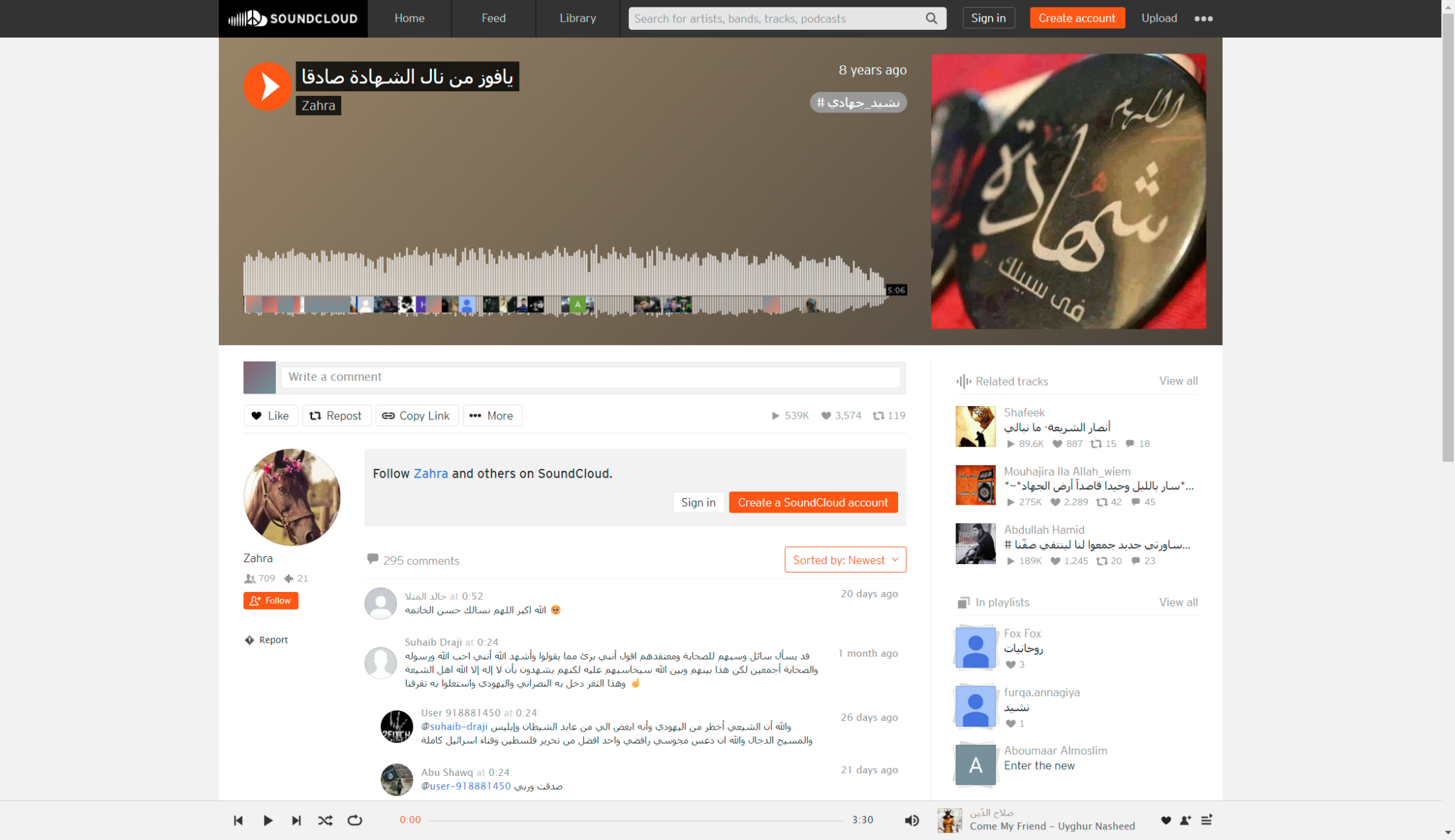
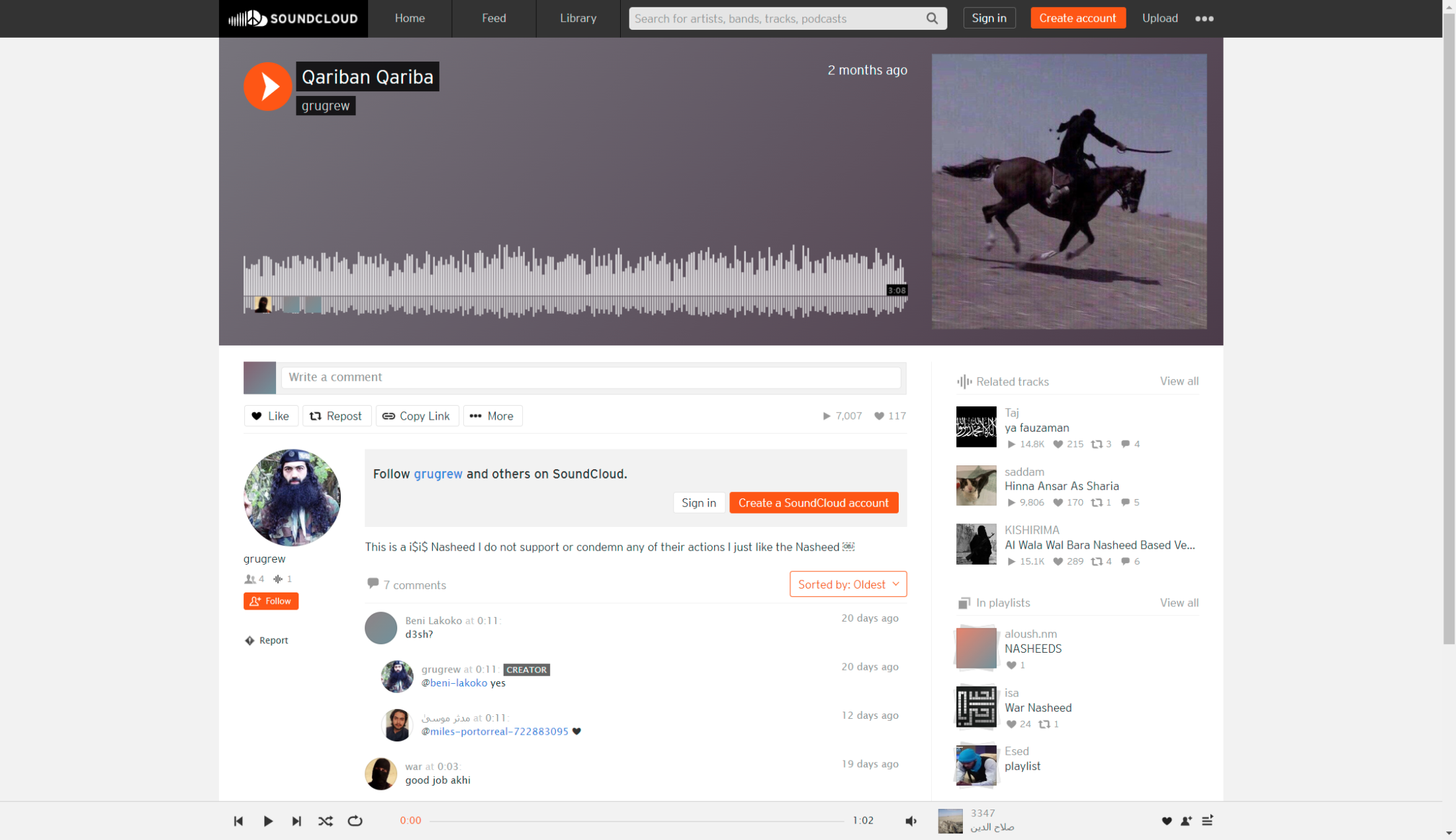




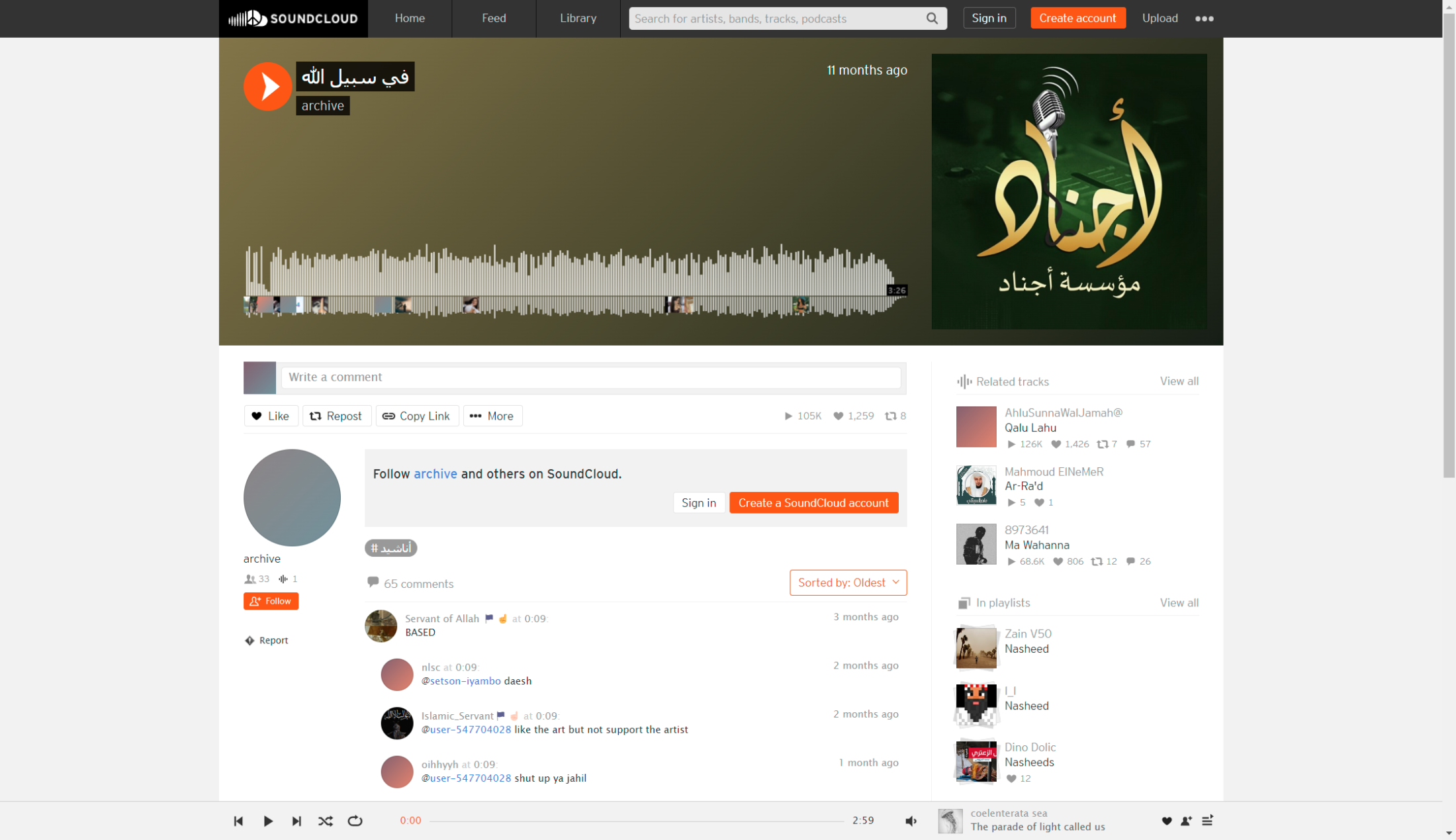

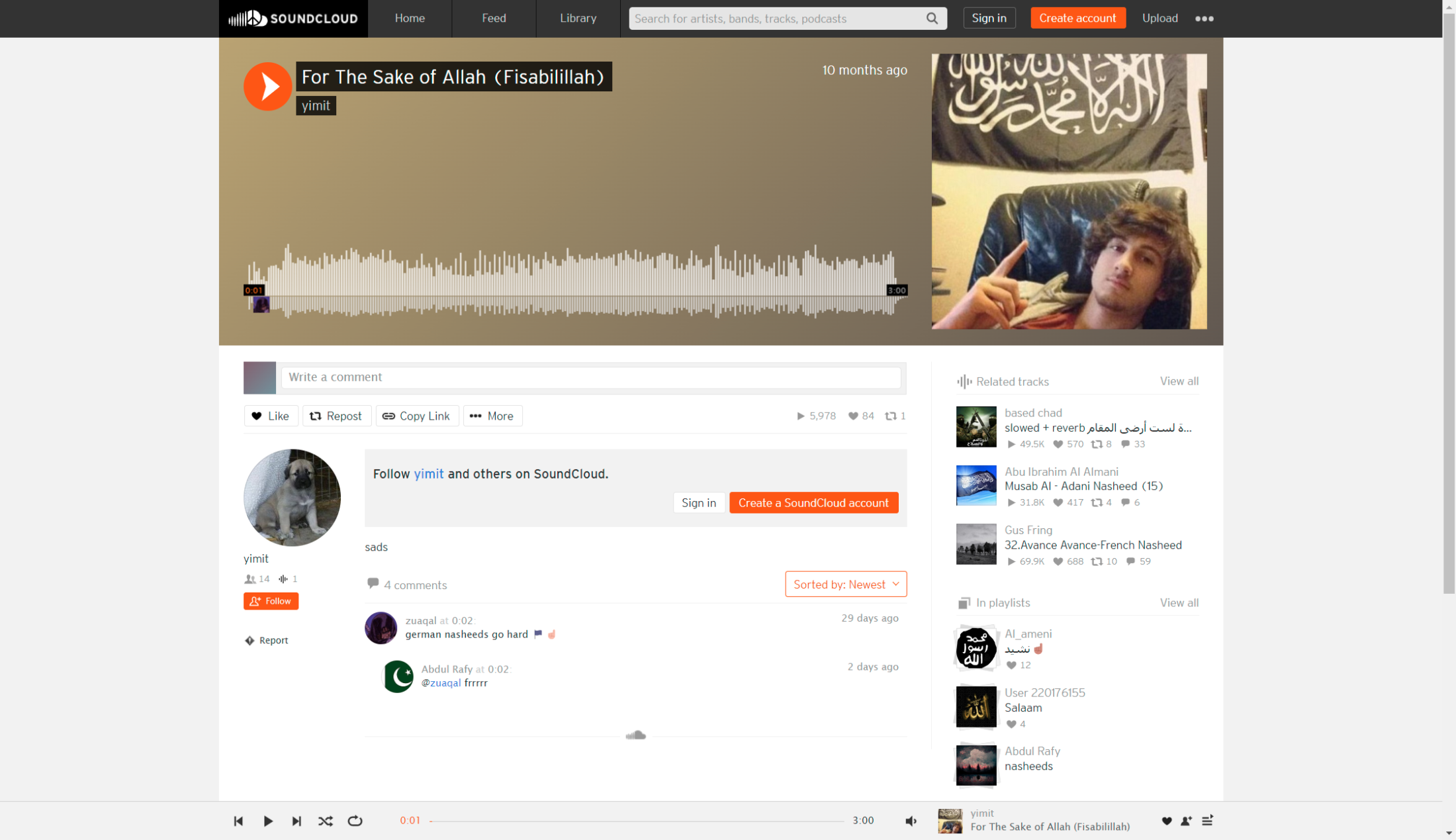



The Easy Accessibility of IS Content on SoundCloud
Streaming SoundCloud tracks does not require creating an account, making it easier to listen to IS content somewhat anonymously. IP addresses and device types are logged by SoundCloud for each stream, whether one has an account or not, but an email, phone number, or any personally identifiable information is not required. By offering a platform for these anashid, SoundCloud unwittingly provides space for the recruitment and radicalization of individuals who may be susceptible to violent extremist messaging. It may also serve to propagate incitement of existing members for sustained loyalty, while the accessibility of these anashid on SoundCloud allows them to reach a broad audience, which includes individuals who may not be actively seeking extremist content.
Strikingly, finding IS content on SoundCloud is incredibly easy. One basic method involves searching for IS media foundations or anashid names in various languages such as English, Arabic, German, French, Turkish, Chinese, and Russian. With such search terms, users quickly discover hundreds of IS anashid and even find custom IS playlists. Alternatively, and an even simpler method, an IS supporter can search for “dawlah,” the Arabic word for “state,” in reference to the “Islamic State.” Supporters also surprisingly employ the use of non-obfuscated hashtags such as “Islamic State nasheeds” and “The State” in different languages.
On the Rocket.Chat server operated by IS, official IS media outlets and supporters have repeatedly announced the posting of anashid and audio statements from IS leaders on SoundCloud. These announcements along with shared links to SoundCloud postings and profiles demonstrate their commitment to using the platform as a haven for their content. For instance, under the seemingly innocuous and now deleted SoundCloud account “jake-tom-40076370,” the IS al-Furqan Foundation had previously shared SoundCloud links to audio statements from the-then IS spokesman. So has the pro-IS translation and propaganda outlet Halummu.
Additionally, IS supporters actively facilitate the posting of content on SoundCloud through platforms like Telegram. “Shabakat al-Shuhada (the Martyrs Network)” is one example of self-titled “media preservation foundations” that serve as IS audio data hoarders and disseminators. A campaign announced by the group (below) earlier this year was dedicated to releasing speeches and statements on SoundCloud from several jihadi leaders, including Abu Bakr al-Baghdadi, Abu Muhammad al-‘Adnani, and Abu Mus’ab al-Zarqawi. The text message accompanying the campaign poster prayed that “God bless our efforts in spreading anashid and other audio files on the SoundCloud platform.” As usual, SoundCloud links with IS anashid, sermons, and speeches followed.
SoundCloud’s Content Removal Policy
SoundCloud’s current content removal policy states that they have an automated content identification system to combat copyright infringement. This system scans the audio of all uploaded tracks and compares it with a database of tracks that rightsholders and digital distributors have requested to be blocked. If a match is detected, the upload is automatically removed. However, when it comes to “extremist ideologies” such as IS material, their policy states that such content will be removed only “when it is reported to our team for review.” This reactive approach is inadequate, considering SoundCloud’s non-user-friendly reporting functionality and the sheer amount of IS content on the platform. Also, this content often hides behind innocent-sounding posts and playlist titles (e.g., “Certified Hood Classics” or random Korean text) and seemingly harmless album art (e.g., celebrity images or memes).
In 2022, Europol’s European Counter Terrorism Centre (ECTC) carried out an operation aimed at removing extremist audio clips from SoundCloud. However, despite the authorities identifying 1,100 illegal profiles and audio files during the operation, IS anashid that were uploaded years prior to the operation still remain on the platform today. The manual process of locating these 1,100 profiles and audio files is time-consuming and prone to human error, highlighting the need for an automated solution.
Hashing and Audio Fingerprinting to Combat IS Anashid
Microsoft PhotoDNA is a well-known technology used to combat the dissemination of child exploitation material online. It employs a hashing framework to generate unique digital fingerprints, or hashes, of images by analyzing their visual characteristics. These features, such as color distribution, texture, and shape, are transformed into numerical representations using specific algorithms designed to create distinct identifiers. PhotoDNA has been highly regarded for its effectiveness in identifying and removing illegal images, and it has even been used by companies like Facebook to combat IS images and videos on their platform. Moreover, Facebook is a part of the broader Global Internet Forum to Counterterrorism, which has its own hash-sharing database of extremist materials online. However, Soundcloud is currently not a member of the consortium, which has 24 member-companies as of July 24, 2023. It is something Soundcloud should consider joining. The Counter Extremism Project’s eGLYPH is another technology that implements a similar mechanism, banning violent extremist content based on hashes.
Taking inspiration from these tools, a similar approach can be applied to address the problem of IS anashid on SoundCloud. Instead of analyzing visual characteristics, an audio fingerprinting process, like the one used by the popular music identification service Shazam, can be employed to capture the unique acoustic features of each uploaded track. By converting ISIS anashid features into unique hashes, SoundCloud could establish a database of known identifiers that represent IS anashid and other audio content such as IS leaders’ speeches.
In fact, SoundCloud need not initially dive deep into the audio fingerprinting process and deal with the spectral, temporal, harmonic, statistical, and time-frequency analysis of IS audio content, but rather, it can simply hash an entire nashid immediately after an upload. And since the release of new audio content from the group is relatively low these days, the need for constantly updating the known-bad database would be minimal.
Proof of Concept
Spending approximately four hours, I used automated techniques with Python and manual searching and selection of profiles and playlists to scrape SoundCloud for IS anashid. The result was a collection of 1,509 IS anashid. To keep my simple experiment fair, I did not actively seek out, for example, anashid with the same title, but rather did what a typical IS supporter may do: search using generic IS-related keywords and access SoundCloud links found in private invite-only and public IS-supporter Telegram channels. With a new Python script, I stripped all anashid of their SoundCloud metadata to remove content like user IDs, playlist names, and album art, so that they yield accurate results and do not conflict with the hashing process. After processing and hashing them using the SHA-256 algorithm, the results were:
- Number of anashid with at least two hashes: 801, or 53%
- Number of anashid with one unique hash: 708, or 47%
I separated and manually reviewed the 47% of anashid with a single unique hash, and I found a significant number of duplicates not included in the 53% count of identical anashid. These duplicates, despite being the exact same composition, were excluded due to slight variations such as being milliseconds shorter in duration, having a slightly lower audio quality, featuring background effects like gunshots and horse neighing, and adding reverberation – all of which drastically change a hash value.
While my basic experiment yielded promising results in removing IS content on SoundCloud, these findings emphasize the limitations of a hash-only approach and highlight the potential for a more advanced audio fingerprinting process. By implementing a Shazam-like technology, these duplicates could be more accurately recognized and incorporated into the categorization process. This comprehensive yet simple approach would provide a more accurate representation of the actual number of identical anashid on SoundCloud. My manual test in fact showed that the scraped anashid duplicate hash count surpasses the initial 53% that my Python script automatically identified.
The resulting database from this framework can be shared with other audio platforms and streaming services for their IS content removal as well. While writing this piece, I identified several multi-lingual jihadi anashid on Spotify too (also not a GIFCT member), some with hundreds of thousands of streams.
This framework is by no means revolutionary, nor is it particularly technically sophisticated, so why isn’t SoundCloud employing it?
Intel Cocktail is a cybersecurity engineer currently working in academia. The author also recently created the website “Intel Cocktail” as an independent research project. You can follow the author @IntelCocktail on Twitter.

